A Novel Accelerometry-Based Metric to Improve Estimation of Whole-Body Mechanical Load
Abstract
1. Introduction
2. Materials and Methods
2.1. Participants
2.2. Experimental Protocol
2.3. Instrumentation
2.3.1. Force Plates
2.3.2. Triaxial Accelerometry
2.4. Data Processing
2.5. Statistical Analysis
3. Results
3.1. Concurrent Validity of the Player Load
3.2. Concurrent Validity of the Accel’Rate
3.3. Effect of Locomotor Task Intensity
3.4. Effect of Sensor Unit Location
4. Discussion
4.1. Validity of the Player Load and Accel’Rate Metrics
4.2. Effect of Accelerometer Position
4.3. Limitations
4.4. Practical Applications
5. Conclusions and Perspectives
6. Patents
Author Contributions
Funding
Data Availability Statement
Acknowledgments
Conflicts of Interest
References
- Barnes, C.; Archer, D.T.; Hogg, B.; Bush, M.; Bradley, P.S. The evolution of physical and technical performance parameters in the English Premier League. Int. J. Sports Med. 2014, 35, 1095–1100. [Google Scholar] [CrossRef]
- Fox, J.L.; Scanlan, A.T.; Stanton, R. A Review of Player Monitoring Approaches in Basketball: Current Trends and Future Directions. J. Strength Cond. Res. 2017, 31, 2021–2029. [Google Scholar] [CrossRef]
- Gabbett, T.J.; Jenkins, D.G.; Abernethy, B. Physical demands of professional rugby league training and competition using microtechnology. J. Sci. Med. Sport 2012, 15, 80–86. [Google Scholar] [CrossRef] [PubMed]
- Jaspers, A.; Brink, M.S.; Probst, S.G.; Frencken, W.G.; Helsen, W.F. Relationships Between Training Load Indicators and Training Outcomes in Professional Soccer. Sports Med. 2017, 47, 533–544. [Google Scholar] [CrossRef] [PubMed]
- Karcher, C.; Buchheit, M. On-court demands of elite handball, with special reference to playing positions. Sports Med. 2014, 44, 797–814. [Google Scholar] [CrossRef] [PubMed]
- Duking, P.; Hotho, A.; Holmberg, H.C.; Fuss, F.K.; Sperlich, B. Comparison of Non-Invasive Individual Monitoring of the Training and Health of Athletes with Commercially Available Wearable Technologies. Front. Physiol. 2016, 7, 71. [Google Scholar] [CrossRef]
- Halson, S.L. Monitoring training load to understand fatigue in athletes. Sports Med. 2014, 44 (Suppl. S2), S139–S147. [Google Scholar] [CrossRef]
- Halson, S.L.; Peake, J.M.; Sullivan, J.P. Wearable Technology for Athletes: Information Overload and Pseudoscience? Int. J. Sports Physiol. Perform. 2016, 11, 705–706. [Google Scholar] [CrossRef]
- Sievanen, H.; Kujala, U.M. Accelerometry-Simple, but challenging. Scand. J. Med. Sci. Sports 2017, 27, 574–578. [Google Scholar] [CrossRef] [PubMed]
- Chambers, R.; Gabbett, T.J.; Cole, M.H.; Beard, A. The Use of Wearable Microsensors to Quantify Sport-Specific Movements. Sports Med. 2015, 45, 1065–1081. [Google Scholar] [CrossRef]
- Wundersitz, D.; Gastin, P.; Robertson, S.; Davey, P.; Netto, K. Validation of a Trunk-mounted Accelerometer to Measure Peak Impacts during Team Sport Movements. Int. J. Sports Med. 2015, 36, 742–746. [Google Scholar] [CrossRef] [PubMed]
- Wundersitz, D.W.T.; Netto, K.J.; Aisbett, B.; Gastin, P.B. Validity of an upper-body-mounted accelerometer to measure peak vertical and resultant force during running and change-of-direction tasks. Sports Biomech. 2013, 12, 403–412. [Google Scholar] [CrossRef]
- Vanrenterghem, J.; Nedergaard, N.J.; Robinson, M.A.; Drust, B. Training Load Monitoring in Team Sports: A Novel Framework Separating Physiological and Biomechanical Load-Adaptation Pathways. Sports Med. 2017, 47, 2135–2142. [Google Scholar] [CrossRef] [PubMed]
- Gómez-Carmona, C.D.; Pino-Ortega, J.; Sánchez-Ureña, B.; Ibáñez, S.J.; Rojas-Valverde, D. Accelerometry-Based External Load Indicators in Sport: Too Many Options, Same Practical Outcome? Int. J. Environ. Res. Public Health 2019, 16, 5101. [Google Scholar] [CrossRef] [PubMed]
- Verheul, J.; Gregson, W.; Lisboa, P.; Vanrenterghem, J.; Robinson, M.A. Whole-body biomechanical load in running-based sports: The validity of estimating ground reaction forces from segmental accelerations. J. Sci. Med. Sport 2019, 22, 716–722. [Google Scholar] [CrossRef]
- Nedergaard, N.J.; Robinson, M.A.; Eusterwiemann, E.; Drust, B.; Lisboa, P.J.; Vanrenterghem, J. The Relationship between Whole-Body External Loading and Body-Worn Accelerometry During Team-Sport Movements. Int. J. Sports Physiol. Perform. 2017, 12, 18–26. [Google Scholar] [CrossRef] [PubMed]
- Barrett, S.; Midgley, A.; Lovell, R. PlayerLoad: Reliability, convergent validity, and influence of unit position during treadmill running. Int. J. Sports Physiol. Perform. 2014, 9, 945–952. [Google Scholar] [CrossRef] [PubMed]
- Bredt, S.; Chagas, M.H.; Peixoto, G.H.; Menzel, H.J.; de Andrade, A.G.P. Understanding Player Load: Meanings and Limitations. J. Hum. Kinet. 2020, 71, 5–9. [Google Scholar] [CrossRef]
- Cavagna, G.A. Force platforms as ergometers. J. Appl. Physiol. 1975, 39, 174–179. [Google Scholar] [CrossRef]
- Rabita, G.; Dorel, S.; Slawinski, J.; Saez-de-Villarreal, E.; Couturier, A.; Samozino, P.; Morin, J.B. Sprint mechanics in world-class athletes: A new insight into the limits of human locomotion. Scand. J. Med. Sci. Sports 2015, 25, 583–594. [Google Scholar] [CrossRef] [PubMed]
- Nicolella, D.P.; Torres-Ronda, L.; Saylor, K.J.; Schelling, X. Validity and reliability of an accelerometer-based player tracking device. PLoS ONE 2018, 13, e0191823. [Google Scholar] [CrossRef] [PubMed]
- Boyd, L.J.; Ball, K.; Aughey, R.J. The reliability of MinimaxX accelerometers for measuring physical activity in Australian football. Int. J. Sports Physiol. Perform. 2011, 6, 311–321. [Google Scholar] [CrossRef] [PubMed]
- Luteberget, L.S.; Holme, B.R.; Spencer, M. Reliability of Wearable Inertial Measurement Units to Measure Physical Activity in Team Handball. Int. J. Sports Physiol. Perform. 2018, 13, 467–473. [Google Scholar] [CrossRef]
- Winter, D.A. Biomechanics and Motor Control of Human Movement, 4th ed.; John Wiley & Sons: Hoboken, NJ, USA, 2009; p. 370. [Google Scholar]
- Hopkins, W.G. Measures of reliability in sports medicine and science. Sports Med. 2000, 30, 1–15. [Google Scholar] [CrossRef] [PubMed]
- Bland, J.M.; Altman, D.G. Statistical methods for assessing agreement between two methods of clinical measurement. Lancet 1986, 1, 307–310. [Google Scholar] [CrossRef]
- Montgomery, P.G.; Pyne, D.B.; Minahan, C.L. The physical and physiological demands of basketball training and competition. Int. J. Sports Physiol. Perform. 2010, 5, 75–86. [Google Scholar] [CrossRef]
- Roell, M.; Roecker, K.; Gehring, D.; Mahler, H.; Gollhofer, A. Player Monitoring in Indoor Team Sports: Concurrent Validity of Inertial Measurement Units to Quantify Average and Peak Acceleration Values. Front. Physiol. 2018, 9, 141. [Google Scholar] [CrossRef]
- Boyd, L.J.; Ball, K.; Aughey, R.J. Quantifying external load in Australian football matches and training using accelerometers. Int. J. Sports Physiol. Perform. 2013, 8, 44–51. [Google Scholar] [CrossRef]
- Luteberget, L.S.; Spencer, M. High-Intensity Events in International Women’s Team Handball Matches. Int. J. Sports Physiol. Perform. 2017, 12, 56–61. [Google Scholar] [CrossRef]
- Polglaze, T.; Dawson, B.; Hiscock, D.J.; Peeling, P. A comparative analysis of accelerometer and time-motion data in elite men’s hockey training and competition. Int. J. Sports Physiol. Perform. 2015, 10, 446–451. [Google Scholar] [CrossRef]
- Wik, E.H.; Luteberget, L.S.; Spencer, M. Activity Profiles in International Women’s Team Handball Using PlayerLoad. Int. J. Sports Physiol. Perform. 2017, 12, 934–942. [Google Scholar] [CrossRef] [PubMed]
- Barrett, S.; Midgley, A.; Reeves, M.; Joel, T.; Franklin, E.; Heyworth, R.; Garrett, A.; Lovell, R. The within-match patterns of locomotor efficiency during professional soccer match play: Implications for injury risk? J. Sci. Med. Sport 2016, 19, 810–815. [Google Scholar] [CrossRef] [PubMed]
- De Leva, P. Adjustments to Zatsiorsky-Seluyanov’s segment inertia parameters. J. Biomech. 1996, 29, 1223–1230. [Google Scholar] [CrossRef]
- Schache, A.G.; Bennell, K.L.; Blanch, P.D.; Wrigley, T.V. The coordinated movement of the lumbo-pelvic-hip complex during running: A literature review. Gait Posture 1999, 10, 30–47. [Google Scholar] [CrossRef]
- Chen, K.Y.; Bassett, D.R., Jr. The technology of accelerometry-based activity monitors: Current and future. Med. Sci. Sports Exerc. 2005, 37, S490–S500. [Google Scholar] [CrossRef]
- Schutte, K.H.; Sackey, S.; Venter, R.; Vanwanseele, B. Energy cost of running instability evaluated with wearable trunk accelerometry. J. Appl. Physiol. 2018, 124, 462–472. [Google Scholar] [CrossRef]
- Ward, D.S.; Evenson, K.R.; Vaughn, A.; Rodgers, A.B.; Troiano, R.P. Accelerometer use in physical activity: Best practices and research recommendations. Med. Sci. Sports Exerc. 2005, 37, S582–S588. [Google Scholar] [CrossRef]
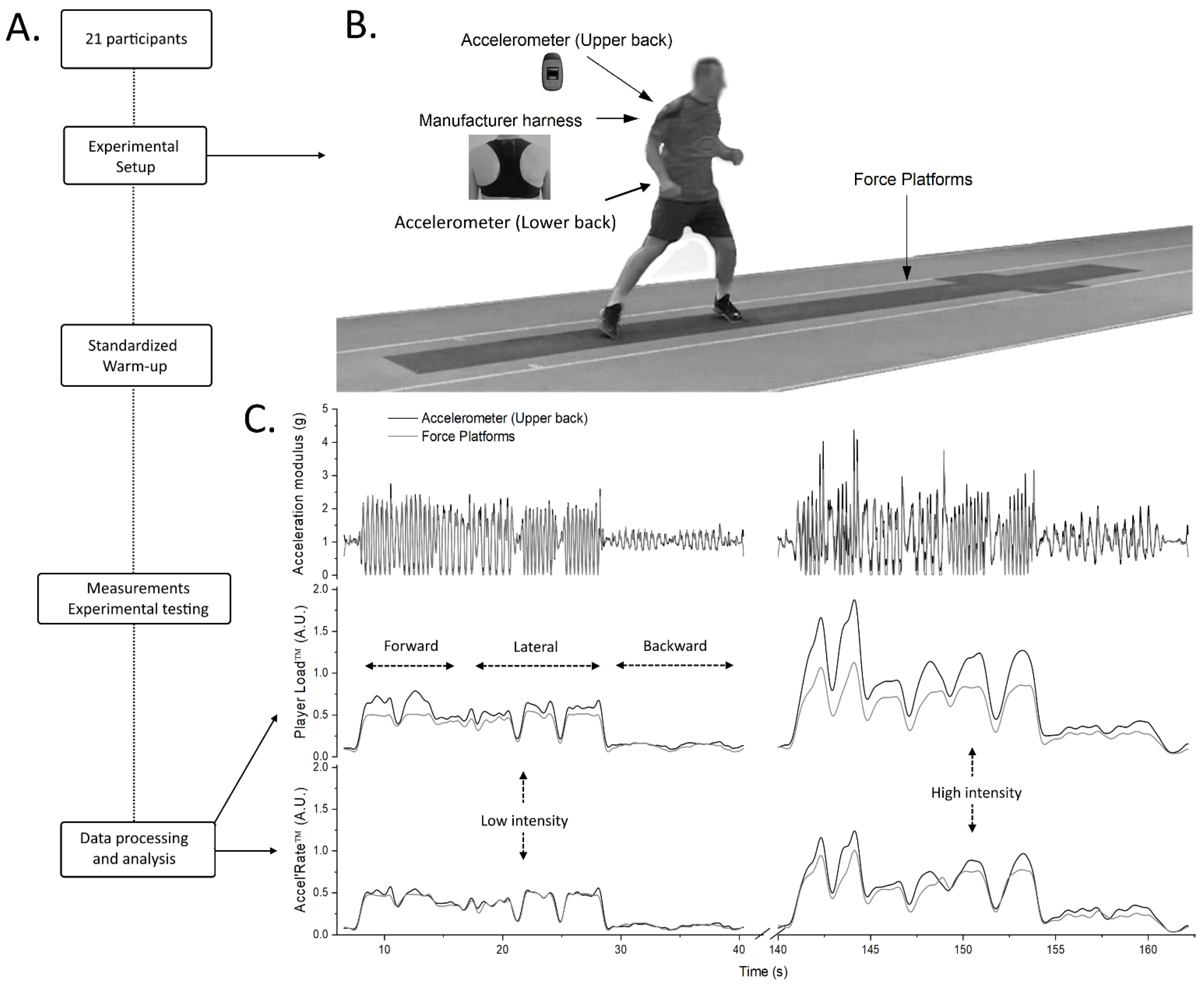
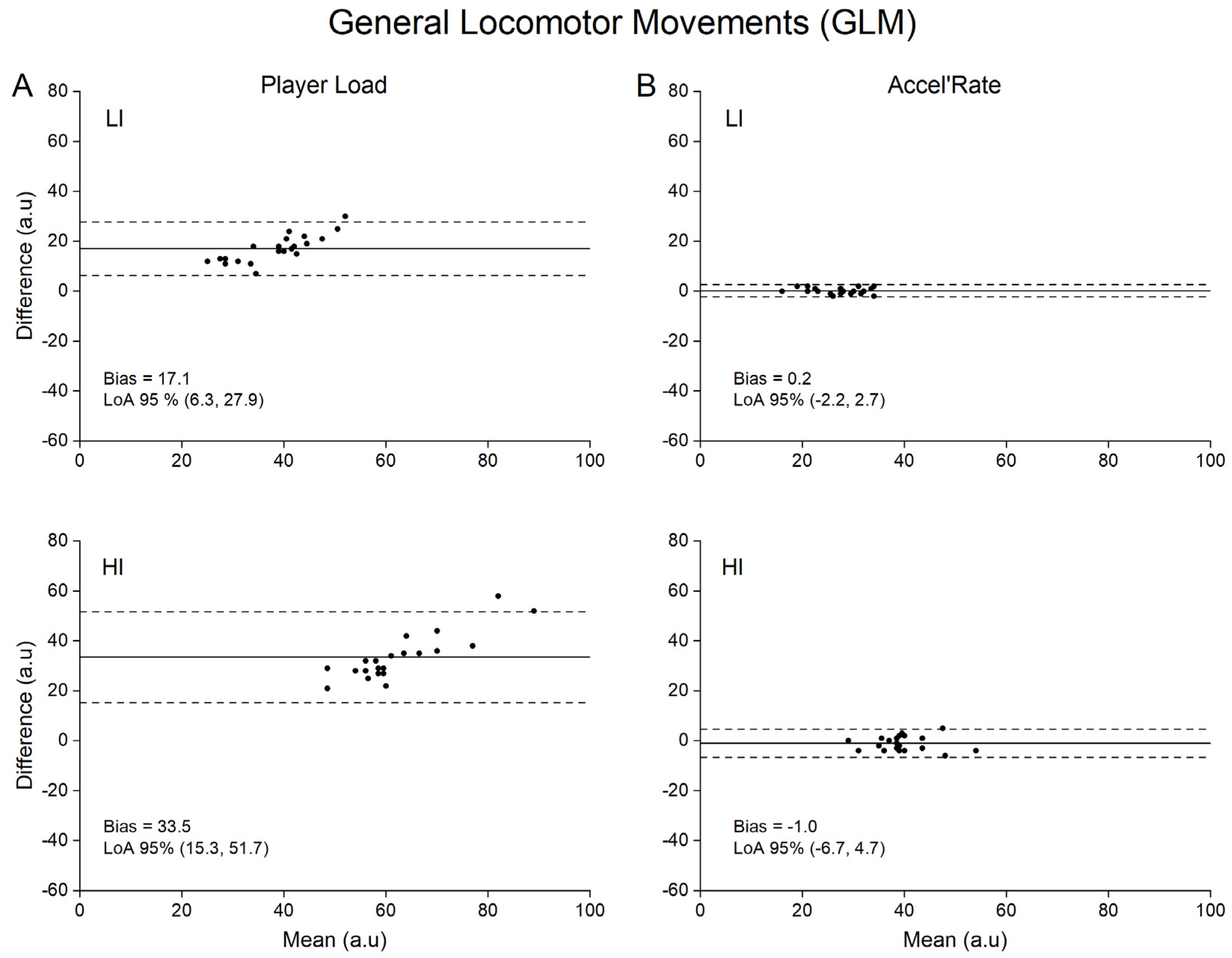
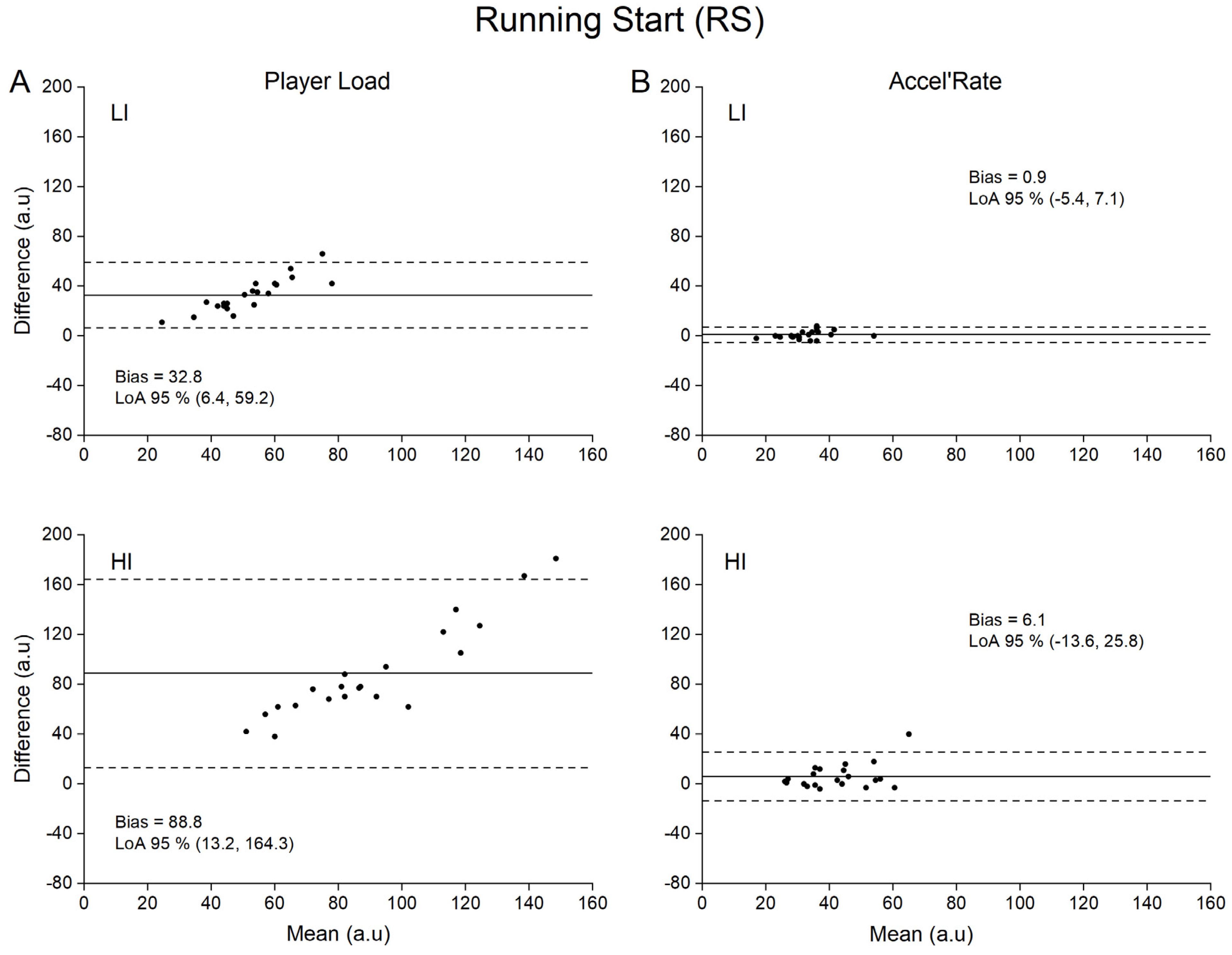
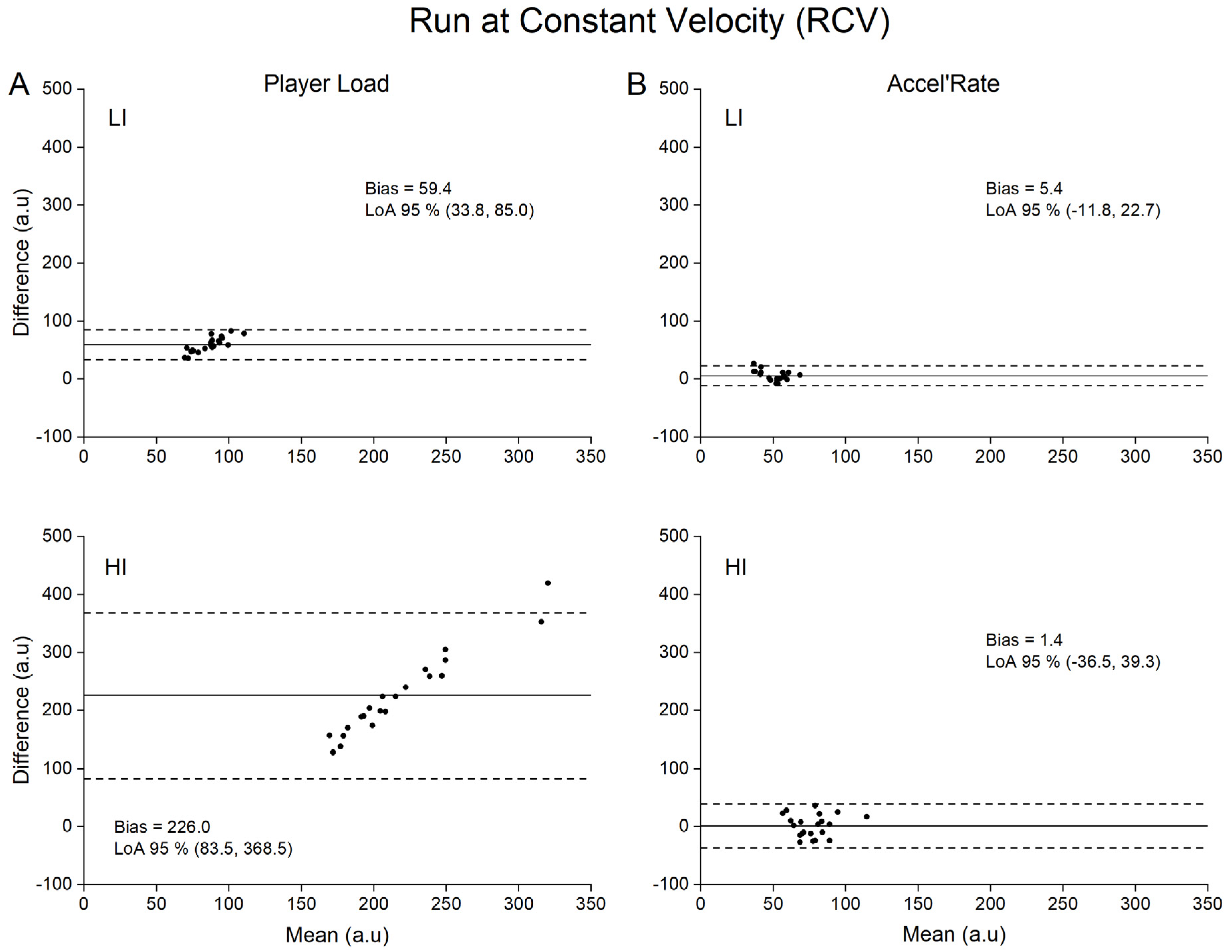
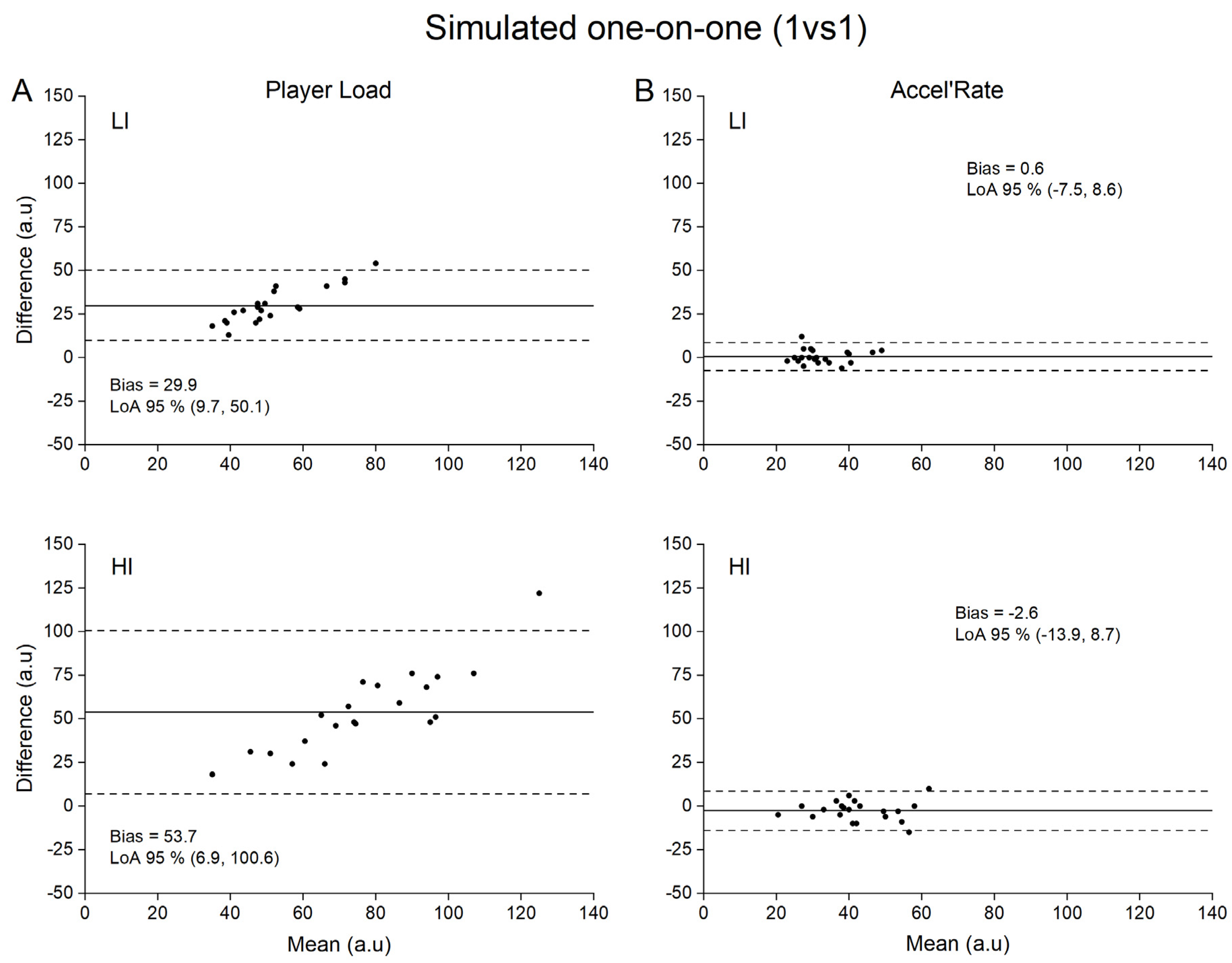
| Movements and Intensity | Player Load | Accel’Rate | |||||||
|---|---|---|---|---|---|---|---|---|---|
| Upper Back | Lower Back | Upper Back | Lower Back | ||||||
| General Locomotor movements (GLM) | |||||||||
| Low intensity | Pearson’s r | 0.90 | [0.77–0.96] | 0.84 | [0.63–0.93] | 0.97 | [0.93–0.99] | 0.90 | [0.76–0.96] |
| Mean bias | 17.10 | (10.78) | 39.66 | (21.71) | 0.24 | (2.47) | 4.10 | (5.51) | |
| Standardized mean bias | 3.08 | (0.45) | 7.16 | (0.91) | 0.05 | (0.11) | 0.79 | (0.25) | |
| Standardized SEE | 0.45 | [0.34–0.65] | 0.56 | [0.43–0.82] | 0.25 | [0.19–0.36] | 0.46 | [0.35–0.67] | |
| High intensity | Pearson r | 0.87 | [0.70–0.95] | 0.80 | [0.57–0.92] | 0.88 | [0.71–0.95] | 0.72 | [0.42–0.88] |
| Mean bias | 33.48 | (18.21) | 81.9 | (34.78) | −1.00 | (5.68) | 4.81 | (8.87) | |
| Standardized mean bias | 5.06 | (0.64) | 12.38 | (1.22) | −0.17 | (0.23) | 0.82 | (0.35) | |
| Standardized SEE | 0.51 | [0.39–0.75] | 0.61 | [0.47–0.89] | 0.50 | [0.38–0.72] | 0.71 | [0.54–1.04] | |
| Running Start (RS) | |||||||||
| Low intensity | Pearson’s r | 0.82 | [0.61–0.93] | 0.81 | [0.58–0.92] | 0.92 | [0.82–0.97] | 0.91 | [0.79–0.96] |
| Mean bias | 32.76 | (26.38) | 54.33 | (39.02) | 0.86 | (6.24) | 6.19 | (10.70) | |
| Standardized mean bias | 4.23 | (0.79) | 7.01 | (1.17) | 0.12 | (0.20) | 0.86 | (0.34) | |
| Standardized SEE | 0.58 | [0.44–0.85] | 0.60 | [0.46–0.88] | 0.39 | [0.30–0.58] | 0.43 | [0.32–0.62] | |
| High intensity | Pearson r | 0.68 | [0.35–0.86] | 0.71 | [0.41–0.88] | 0.71 | [0.39–0.87] | 0.80 | [0.57–0.92] |
| Mean bias | 88.76 | (75.55) | 121.19 | (77.61) | 6.09 | (19.74) | 6.90 | (16.07) | |
| Standardized mean bias | 7.48 | (1.48) | 10.21 | (1.52) | 0.59 | (0.44) | 0.67 | (0.36) | |
| Standardized SEE | 0.75 | [0.57–1.10] | 0.72 | [0.55–1.05] | 0.73 | [0.55–1.06] | 0.61 | [0.47–0.90] | |
| Run at Constant Velocity (RCV) | |||||||||
| Low intensity | Pearson’s r | 0.72 | [0.41–0.88] | 0.34 | [−0.11–0.67] | 0.65 | [0.30–0.84] | 0.61 | [0.25–0.83] |
| Mean bias | 59.38 | (25.6) | 96.52 | (45.33) | 5.43 | (17.25) | 14.57 | (18.83) | |
| Standardized mean bias | 9.01 | (0.9) | 14.65 | (1.6) | 0.47 | (0.35) | 1.26 | (0.38) | |
| Standardized SEE | 0.72 | [0.55–1.05] | 0.97 | [0.73–1.41] | 0.78 | [0.59–1.14] | 0.81 | [0.62–1.18] | |
| High intensity | Pearson’s r | 0.53 | [0.13–0.78] | 0.32 | [−0.13–0.66] | 0.31 | [−0.14–0.66] | 0.25 | [−0.20–0.62] |
| Mean bias | 226 | (142.50) | 337.96 | (136.01) | 1.38 | (37.87) | 23.14 | (47.22) | |
| Standardized mean bias | 21.88 | (3.20) | 32.71 | (3.06) | 0.09 | (0.55) | 1.44 | (0.68) | |
| Standardized SEE | 0.87 | [0.66–1.27] | 0.97 | [0.74–1.42] | 0.95 | [0.74–1.42] | 0.97 | [0.75–1.45] | |
| Simulated one-on-one (1 vs. 1) | |||||||||
| Low intensity | Pearson’s r | 0.89 | [0.75–0.96] | 0.87 | [0.71–0.95] | 0.84 | [0.65–0.94] | 0.75 | [0.48–0.89] |
| Mean bias | 29.91 | (20.24) | 60.76 | (31.91) | 0.57 | (8.07) | 5.71 | (11.66) | |
| Standardized mean bias | 3.75 | (0.59) | 7.62 | (0.93) | 0.08 | (0.26) | 0.78 | (0.38) | |
| Standardized SEE | 0.46 | [0.35–0.67] | 0.50 | [0.49–0.93] | 0.55 | [0.42–0.80] | 0.68 | [0.51–0.99] | |
| High intensity | Pearson’s r | 0.78 | [0.53–0.91] | 0.85 | [0.67–0.94] | 0.86 | [0.69–0.94] | 0.84 | [0.63–0.93] |
| Mean bias | 53.71 | (46.84) | 101.57 | (55.86) | −2.62 | (11.30) | 1.43 | (13.19) | |
| Standardized mean bias | 4.22 | (0.85) | 7.98 | (1.02) | −0.24 | (0.24) | 0.13 | (0.28) | |
| Standardized SEE | 0.64 | [0.16–0.40] | 0.53 | [0.16–0.40] | 0.52 | [0.39–0.76] | 0.56 | [0.43–0.82] | |
Publisher’s Note: MDPI stays neutral with regard to jurisdictional claims in published maps and institutional affiliations. |
© 2021 by the authors. Licensee MDPI, Basel, Switzerland. This article is an open access article distributed under the terms and conditions of the Creative Commons Attribution (CC BY) license (https://creativecommons.org/licenses/by/4.0/).
Share and Cite
Hollville, E.; Couturier, A.; Guilhem, G.; Rabita, G. A Novel Accelerometry-Based Metric to Improve Estimation of Whole-Body Mechanical Load. Sensors 2021, 21, 3398. https://doi.org/10.3390/s21103398
Hollville E, Couturier A, Guilhem G, Rabita G. A Novel Accelerometry-Based Metric to Improve Estimation of Whole-Body Mechanical Load. Sensors. 2021; 21(10):3398. https://doi.org/10.3390/s21103398
Chicago/Turabian StyleHollville, Enzo, Antoine Couturier, Gaël Guilhem, and Giuseppe Rabita. 2021. "A Novel Accelerometry-Based Metric to Improve Estimation of Whole-Body Mechanical Load" Sensors 21, no. 10: 3398. https://doi.org/10.3390/s21103398
APA StyleHollville, E., Couturier, A., Guilhem, G., & Rabita, G. (2021). A Novel Accelerometry-Based Metric to Improve Estimation of Whole-Body Mechanical Load. Sensors, 21(10), 3398. https://doi.org/10.3390/s21103398






